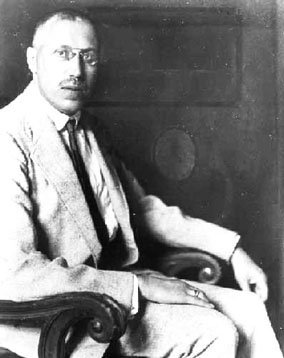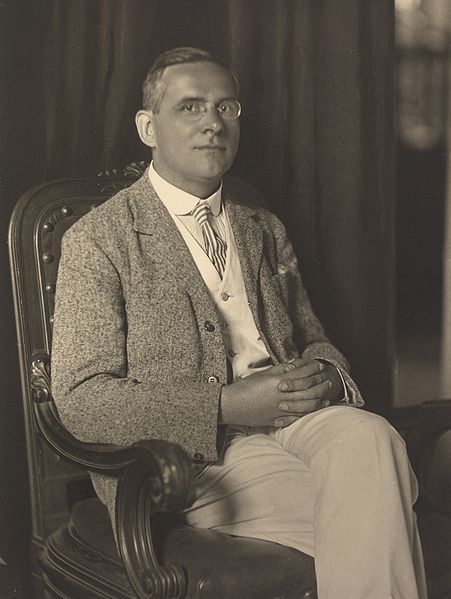<Back to Index>
- Mathematician and Philosopher Hans Hahn, 1879
- Philosopher and Physicist Friedrich Albert Moritz Schlick, 1882
PAGE SPONSOR

Hans Hahn (September 27, 1879 – July 24, 1934) was an Austrian mathematician who made contributions to functional analysis, topology, set theory, the calculus of variations, real analysis and order theory.
Born at Vienna as the son of a higher government official of the k.k. Telegraphen - Korrespondenz - Bureau (since 1946 named with the linguistically strange mixture "Austria Presse Agentur"), in 1898 he became a student at the Universität Wien starting with a study of law. In 1899 he switched over to mathematics and spent some time at the universities of Strasbourg, Munich and Göttingen. In 1902 he obtained his Ph.D. in Vienna.
He was appointed to the teaching staff (Habilitation) in Vienna in 1905. After 1905 - 1906 as a stand-in for Otto Stolz at Innsbruck and some further years as a Privatdozent in Vienna, he was nominated in 1909 Professor extraordinarius in Czernowitz, at that time a town within the empire of Austria. After joining the Austrian army in 1915, he was badly wounded in 1916 and became again Professor extraordinarius, now in Bonn. In 1917 he was nominated a regular Professor there and in 1921 he returned to Vienna with this title, where he stayed until his rather early death in 1934 at the age of 54, following a surgery. He had married Eleonore ("Lilly") Minor in 1909 and they had a daughter, Nora (born 1910).
He was also interested in philosophy, and was part of a discussion group concerning Mach's positivism with Otto Neurath and Phillip Frank prior to the First World War. In 1922, he helped arrange Moritz Schlick's entry into the group, which led to the founding of the Vienna Circle, the group that was at the center of logical positivist thought in the 1920s. His most famous student was Kurt Gödel, whose Ph.D. thesis was completed in 1929.
Hahn's contributions to mathematics include the Hahn – Banach theorem and (independently of Banach and Steinhaus) the uniform boundedness principle. Other theorems include:
- the Hahn decomposition theorem;
- the Hahn embedding theorem;
- the Hahn – Kolmogorov theorem;
- the Hahn – Mazurkiewicz theorem;
- the Vitali – Hahn – Saks theorem.
Hahn was also a co-author of the book Set Functions. It was published in 1948, fourteen years after his death in Vienna in 1934.

Friedrich Albert Moritz Schlick (April 14, 1882 – June 22, 1936) was a German philosopher, physicist and the founding father of logical positivism and the Vienna Circle.
Schlick was born in Berlin to a wealthy family, his father was Ernst Albert Schlick and his mother was Agnes Arndt. He studied physics at Heidelberg, Lausanne, and, ultimately, the University of Berlin under Max Planck. In 1904, he completed his dissertation essay, "Über die Reflexion des Lichts in einer inhomogenen Schicht" ("On the Reflection of Light in a Non - Homogeneous Medium"). After a year as Privatdozent at Göttingen, he turned to the study of Philosophy in Zurich. In 1908, he published Lebensweisheit ("The Wisdom of Life"), a slim volume about eudemonism, the theory that happiness is the highest ethical pursuit. His habilitation essay, "Das Wesen der Wahrheit nach der modernen Logik" ("The Nature of Truth According to Modern Logic"), was published in 1910. Several essays about aesthetics followed, whereupon Schlick turned his attention to problems of epistemology, the philosophy of science, and more general questions about science. In this last category, Schlick distinguished himself by publishing a paper in 1915 about Einstein's special theory of relativity, a topic only ten years old. He also published Raum und Zeit in der gegenwärtigen Physik ("Space and Time in Modern Physics"), which extended his earlier results by applying Poincaré's geometric conventionalism to explain Einstein's adoption of a non - Euclidean geometry in the General Theory of Relativity.
After early appointments at Rostock and Kiel, in 1922 Schlick assumed the chair of Naturphilosophie at the University of Vienna which had previously been held by Ludwig Boltzmann and Ernst Mach. Schlick displayed an unusual success in organizing talented individuals in the philosophical and scientific spheres. When Schlick arrived in Vienna, he was invited to lead a group of scientists and philosophers who met regularly (on Thursday evenings in the Chemistry Building) to discuss philosophical topics in the sciences. Early members included the mathematician Hans Hahn and, within a few years, they were joined by Rudolf Carnap, Herbert Feigl, Kurt Gödel, Otto Neurath, Friedrich Waismann and others. They initially called themselves the Ernst Mach Association, but forever after they have been known as the Vienna Circle. In the years 1925 - 1926, the Thursday night group discussed recent work in the foundations of mathematics by Gottlob Frege, Bertrand Russell and Ludwig Wittgenstein. Wittgenstein's book, Tractatus Logico - Philosophicus, was a work of terse, lapidary brilliance that advanced, among other things, a logical theory of symbolism and a "picture" or "model" theory of language. Schlick and his group were impressed by the work, devoting considerable time to its study and, even when it was no longer the principal focus of their discussion, it was mentioned in discussion. Eventually Wittgenstein agreed to meet with Schlick and other Circle members to discuss the Tractatus and other ideas but he later found it necessary to restrict the visitors to sympathetic interlocutors. Through Schlick's influence, Wittgenstein was encouraged to consider a return to philosophy after some ten years away from the field. Despite this, Schlick and Waismann's discussions with Wittgenstein continued until the latter felt that germinal ideas had been used without permission in an essay by Carnap, a charge of dubious merit. But he continued discussions in letters to Schlick after he no longer met with other Circle members.
Schlick had worked on his Allgemeine Erkenntnislehre (General Theory of Knowledge) between 1918 and 1925, and, though later developments in his philosophy were to make various contentions of his epistemology untenable, the General Theory is perhaps his greatest work in its acute reasoning against synthetic a priori knowledge. This critique of synthetic a priori knowledge argues that the only truths which are self - evident to reason are statements which are true as a matter of definition, such as the statements of formal logic and mathematics. The truth of all other statements must be evaluated with reference to empirical evidence. If a statement is proposed which is not a matter of definition, and not capable of being confirmed or falsified by evidence, that statement is "metaphysical", which is synonymous with "meaningless", or "nonsense". This is the principle upon which members of the Vienna Circle were most clearly in agreement - with each other, as well as with Wittgenstein.
Between 1926 and 1930, Schlick labored to finish Fragen der Ethik (Problems of Ethics), in which he surprised some of his fellow Circlists by including ethics as a viable branch of philosophy. In his 1932 - 33 contribution to Erkenntnis, "Positivism and Realism", Schlick offered one of the most illuminating definitions of positivism as every view "which denies the possibility of metaphysics". Accordingly he defined metaphysics as the doctrine of “true being”, “thing in itself” or “transcendental being”, a doctrine which obviously "presupposes that a non - true, lesser or apparent being stands opposed to it". Therefore in this work he bases the positivism on a kind of epistemology which holds that the only true beings are givens or constituents of experience. Also during this time, the Vienna Circle published The Scientific View of the World: The Vienna Circle as a homage to Schlick. Its strong anti - metaphysical stance crystallized the viewpoint of the group.
Carnap, in his book Logical Syntax of Language, included a comment by Schlick on Wittgenstein 's Tractatus.
With the rise of the Nazis in Germany and the Austrofascism in Austria, many of the Vienna Circle's members left for America and the United Kingdom. Schlick, however, stayed on at the University of Vienna. When visited by Herbert Feigl in 1935, he expressed dismay at events in Germany. On June 22, 1936, Schlick was ascending the steps of the University for a class when he was confronted by a former student, Johann Nelböck, who killed Schlick with a pistol. The court declared Nelböck to be fully compos mentis, he confessed to the act, was detained without any resistance, but was unrepentant. The delinquent used the judicial proceedings as a chance to present himself and his ideology in the public. He claimed that Schlick's anti - metaphysical philosophy had "interfered with his moral restraint". In another version of the events, the murderer covered all political causes up and claimed, that he was motivated by jealousy over his failed attachment to the female student Sylvia Borowicka, leading to a paranoid delusion about Schlick as his rival and persecutor. Nelböck was tried and sentenced, but the event became a distorted cause célèbre around which crystallized the growing nationalist and anti - Jewish sentiments in the city. (The fact that Schlick was not actually Jewish did not seem to matter to propagandists capitalizing on the crime.) After the annexation of Austria into Nazi Germany in 1938 the assassin was released on license after serving 2 years of a 10 year sentence.Schlick interprets Wittgenstein's position as follows: philosophy "is that activity by which the meaning of propositions is established or discovered" ; it is a question of "what the propositions actually mean. The content, soul, and spirit of science naturally consist in what is ultimately meant by its sentences; the philosophical activity of rendering significant is thus the alpha and omega of all scientific knowledge".
— Carnap, Logical Syntax of language
Schlick's enduring contribution to the world of philosophy is as the fount of logical positivism. His humanity, good will, gentleness, and especially his encouragement have been documented by many of his peers. Herbert Feigl and Albert Blumberg, in their excellent introduction to "General Theory of Knowledge," have written,
No other thinker was so well prepared to give new impetus to the philosophical questings of the younger generation. Though many of his students and successors have attained a higher degree of exactitude and adequacy in their logical analyses of problems in the theory of knowledge, Schlick had an unsurpassed sense for what is essential in philosophical issues.
— Feigl and Blumberg, Introduction, General Theory of Knowledge